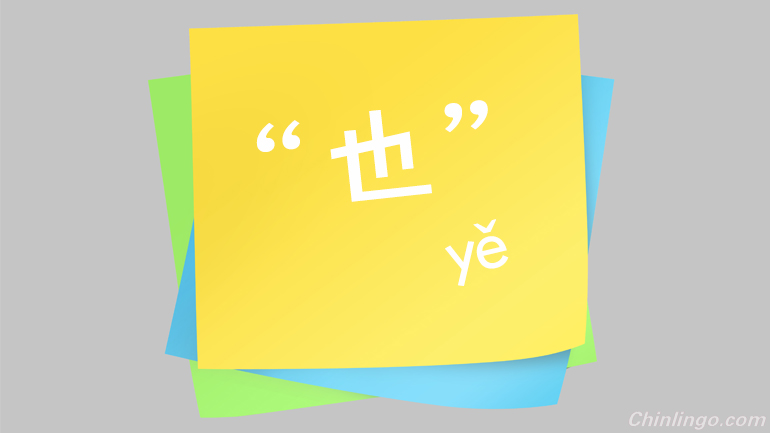
The English adverb "too" or "also" is expressed in Chinese as 也 (yě). In Chinese, it needs to always come before the verb or adjective.
英文的副词"too"或"also"可以用中文的"也 (yě)"来表达。中文里,这个字必须放于动词或者形容词之前。
也 with Verb Phrases
"也" 和动词短语
Since it is an adverb, 也 (yě) is inserted after the subject, before the verb or auxiliary verb:
"也 (yě)"作为副词,要放在主语之后,动词或助动词之前。
Subject + 也 + [Verb / Verb Phrase]
主语+也+[动词/动词短语]
Please note that in English, we replace the word "too" with "either" in negative sentences. For example:
注意,英文里我们会把否定句中的"too"换成"either"。例如:
A: I like cats.
A: 我喜欢猫。
B: I like cats too.
B: 我也喜欢猫。
A: I don't like cats.
A: 我不喜欢猫。
B: I don't like cats either.
B: 我也不喜欢猫。
In Chinese, regardless of whether the sentence is positive or negative, 也 (yě) is used the same way. Just make sure you put the 也 (yě) before the 不 (bù) or other negative part.
在中文里,不管句子是肯定的还是否定的,"也 (yě)" 字都可以同样使用。不过要确保"也 (yě)" 放于"不 (bù)" 或其他否定部分的前面。
Examples
例子
我 也 喜欢 。
Wǒ yě xǐhuān.
I like it too. / I also like it.
他们 也 是 法国 人 。
Tāmen yě shì Fǎguó rén.
They are also French.
他 也 不 知道 。
Tā yě bù zhīdao.
He doesn't know either.
我 也 想 学 中文 。
Wǒ yě xiǎng xué Zhōngwén.
I, too, want to study Chinese.
你 是 北京 人 ? 我 也 是 。
Nǐ shì Běijīng rén? Wǒ yě shì.
Are you a Beijinger? I am too.
我 也 喜欢 吃 水饺 。
Wǒ yě xǐhuān chī shuǐjiǎo.
I like to eat boiled dumplings too.
你 也 喜欢 喝 啤酒 吗 ?
Nǐ yě xǐhuān hē píjǐu ma?
Do you like to drink beer too?
你 也 觉得 这 个 餐厅 不 好 吗 ?
Nǐ yě juéde zhè gè cāntīng bù hǎo ma?
Do you also think this restaurant isn't good?
也 with Adjectives
"也"和形容词
也 (yě) can also be used with adjectives. Remember that for simple "noun + adjective" sentences you normally need to include an adverb like 很 (hěn) before the adjective. In that case, just put the 也 (yě) before the adverb.
"也 (yě)"可以和形容词搭配使用。记住,对于"名词+形容词"这样的简单句,一般你需要用上副词"很 (hěn)"。这种情况下,把"也 (yě)"直接放副词之前。
Subject + 也 + Adverb + Adjective
主语+也+副词+形容词
Examples
例子
你 也 很 高 。
Nǐ yě hěn gāo.
You are also tall.
昨天 很 冷 , 今天 也 很 冷 。
Zuótiān hěn lěng, jīntiān yě hěn lěng.
Yesterday was very cold, and today is also very cold.
这 种 酒 也 很 好喝 。
Zhè zhǒng jiǔ yě hěn hǎohē.
This kind of alcohol is also very good.
我 爸爸 也 很 有钱 。
Wǒ bàba yě hěn yǒuqián.
My dad is also very rich.
湖南 菜 也 很 辣 。
Húnán cài yě hěn là.
Hunan food is very spicy too.
Expressing "me too" with 也
"也"表达"我也是"
It can be tricky to know how to say "me too" when you first study 也 (yě), as you can't say "wǒ yě" all by itself. That's not a complete sentence; you can't just leave 也 (yě) hanging there with nothing after it.
初学"也 (yě)"字的时候,想知道用它如何表达"me too"是挺棘手的,因为不能单独就说"我也 (wǒ yě)",这不是完整的句子。其后面也不能没跟其他内容就直接把"也 (yě)"晾在那。
The correct sentence is "wǒ yě shì", which literally means, "I am too," but can also stand in for "me too."
正确的句子结构是"我也是 (wǒ yě shì)",直译就是"I am too"的意思,不过也表示"me too"的意思。
The correct structure uses the verb 是 (shì):
使用"是 (shì)"的正确句子结构:
我 也 是。(The 是 fills in for whatever was just said.)
Wǒ yě shì. (这里的"是"代表之前所说的内容)
I am too. / Me too.
Always put something after 也!
记得"也"的后面要跟上内容!
Examples
例子
The "me too" structure works with other subjects, as well.
"我也是"这个结构同样也适用于其他人称主语。
他 也 是 。
Tā yě shì.
He is too. / Him too.
我 太太 也 是 。
Wǒ tàitai yě shì.
My wife is too. / My wife too.
中国 人 也 是 。
Zhōngguó rén yě shì.
Chinese people are too. / Chinese people too.
巧克力 也 是 。
Qiǎokèlì yě shì.
Chocolate is too. / Chocolate too.
冰 的 可乐 好喝 , 咖啡 也 是 。
Bīng de kělè hǎohē, kāfēi yě shì.
Cold cola is good, and cold coffee is too.
他 不 吃 肉 , 我 也 是 。
Tā bù chī ròu, wǒ yě shì.
He doesn't eat meat, and neither do I.
你 喜欢 冬天 , 我 也 是 。
Nǐ xǐhuān dōngtiān, wǒ yě shì.
You like the winter, and so do I.
You'll notice that some of those translations use "so do I." The Chinese works exactly the same; they're just translated that way to produce more natural-sounding English.
你会注意到其中一些英文翻译用的是"so do I",而中文也一样。其实这样翻译只是为了接近发音更地道的英文。



 闽公网安备 35020302035673号
闽公网安备 35020302035673号
0 responses on "The uses of "也" in Chinese"